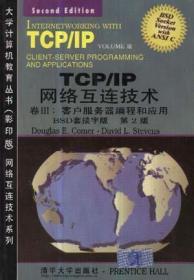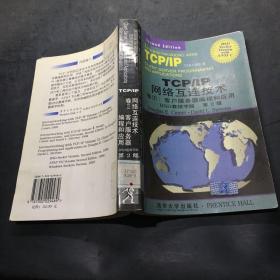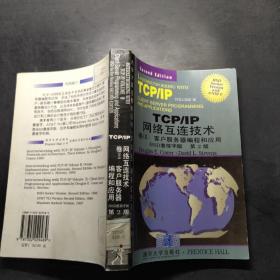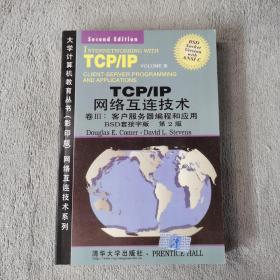
网络互连技术系列
¥ 11.2 3.5折 ¥ 32 全新
仅1件
北京朝阳
认证卖家担保交易快速发货售后保障
作者[美];
出版社清华大学出版社
出版时间1998-12
版次1
装帧精装
上书时间2024-11-14
- 最新上架
商品详情
- 品相描述:全新
图书标准信息
- 作者 [美];
- 出版社 清华大学出版社
- 出版时间 1998-12
- 版次 1
- ISBN 9787302029489
- 定价 32.00元
- 装帧 精装
- 开本 其他
- 纸张 其他
- 页数 519页
- 【内容简介】
-
内容简介
TCP/IP网络互连技术系列的第Ⅲ卷讨论客户/服
务器编程和应用.讲述了构筑所有分布式计算系统的客
户/服务器计算模型的基本概念,内容包括各种不同的
服务器设计方法,以及用来构造客户/服务器的各种工具
和技术,包括远程调用RPC。书中包括了用来说明每种
设计和工具的运行程序示例的源代码。
第Ⅲ卷有三个版本:分别对应于广为应用的BSD
套接字,AT&TTLI接口和WindowsSockets。本书
是BSD套接字版,在所有编程实例中使用BSDUNIX
套接字机制。
- 【目录】
-
Contents
Foreword xxiii
Preface xxv
Chapter 1 Introduction And Overview
1.1 UseOfTCP/IP
1.2 Designing Applications For A Distributed Environment
1.3 Standard And Nonstandard Application Protocols
1.4 An Example Of Standard Application Protocol Use
1.5 An Example Connection
1.6 Using TELNET To Access An Altemative Service
1.7 Application Protocols And Software Flexibility
1.8 Viewing Services From The Provider's Perspective
1.9 The Remainder OfThis Texl
1.10 Summary
Chapter 2 The Client Server Model And Software Design
2.1 Introduction
2.2 Motivation
2.3 Terminology And Concepts
2.3.1 Clients And Servers
2.3.2 Privilege And Complexity
2.3.3 Standard Vs. Nonstandard Client Software
2.3.4 Parameteriz.ation Of Clients
2.3.5 Connectionless Vs. Connection-Oriented Servers
2.3.6 Stateless Vs. Stateful Servers
2.3.7 A Stateful File Server Example
2.3.8 Statelessness Is A Prolocol Issue
2.3.9 Servers As Clients
2.4 Summary
Chapter 3 Concurrent Processing In Cllent-Server Software
3.1 Inlroduction
3.2 Concurrency In Networks
3.3 Concurrency In Servers
3.4 Terminology And Concepts
3.4.1 The Process Concept
3.4.2 Programs vs. Processes
3.4.3 Procedure Calls
3.5 An Example OfConcurrent Process Creation
3.5.1 A Sequential C Example
3.5.2 A Concurrent Version
3.5.3 Timeslicing
3.5.4 Making Processes Diverge
3.6 Executing New Code
3.7 ContextSwitching And Protowl Software Design
3.8 Concurrency And Asynchronous 1/0
3.9 Summary
Chapter 4 Program Interface To Protocols
4.1 Introduction
4.2 Loosely Specified Protocol Software Interface
4.2.1 Advantages And Disadvantages
4.3 Interface Functionality
4.4 Conceptual Interface Specification
4.5 System Calls
4.6 Two Basic Approaches To Network Communication
4.7 The Basic 1/0 Functions Available In UNIX
4.8 Using UNIX 1/0 With TCP/IP
4.9 Summary
Chapter 5 The Socket Interface
5.1 Introduction
5.2 Berkeley Sockets
5.3 Specifying A Protocol Interface
5.4 The Socket Abstraction
5.4.1 Socket Descriptors And File Descriptors
5.4.2 System Data Structures For Sockets
5.4.3 Using Sockets
5.5 Specifying An Endpoint Address
5.6 A Generic Address Structure
5.7 Major System Calis Used With Sockets
5.7.1 The Socket Call
5.7.2 The Connect Call
5.7.3 TheWriteCall
5.7.4 TheReadCall
5.7.5 TheCloseCall
5.7.6 TheBindCall
5.7.7 The Listen Call
5.7.8 The Accept Call
5.7.9 Summary OfSockel Calls Used With TCP
5.8 Utilily Routines For Integer Conversion
5.9 Vsing Socket Calls In A Program
5.10 Symbolic Constants For Socket Call Parameters
5.11 Summarv
Chapter 6 Algorithms And Issues In Client Software Deslgn
6.1 Introduction
6.2 Leaming Algorithms Instead Of Details
6.3 Client Architecture .
6.4 Idenlifying The Localion OfA Server
6.5 Parsing An Address Argument
6.6 Looking Up A Domain Name
6.7 Looking Up A Well-Known Port By Name
6.8 Port Numbers And Network Byle Order
6.9 Looking Up A Protocol By Name
6.10 The TCP Clienl Algorithm
6.11 Allocating A Socket
6.12 Choosing A Local Protocol Port Number
6.13 A Fundamental Problem In Choosing A Local IP Address
6.14 Connecling A TCP Socket To A Server
6.15 Communicating With The Server Using TCP
6.16 Reading A Response From A TCP Connection
6.17 Closing A TCP Connection
6.17.1 The Need For Partial Close
6.17.2 A Partial Close Operation
6.18 Programming A UDP Client
Chapter 7 Example Client Software
7.1 Introduction
7.2 The Importance OfSmall Examples
7.3 Hiding Details
7.4 An Example Procedure Library For Client Programs
7.5 Implementation Of ConnectTCP
7.6 Implementation OfConnectUDP
7.7 A Procedure That Forms Connections
7.8 Using The Example Library
7.9 The DA YTIME Service
7.10 Implemenlation OfA TCP Client For DAYTIME
7.11 Reading From A TCP Connection
7.12 The TIME Service
7.13 Accessing The TIME Service
7.14 Accurate Times And Network Delays
7.15 A UDP Clienl For The TIME Service
7.16 The ECHO Service
7.17 A TCP Client For The ECHO Service
7.18 A UDP Client For The ECHO Service
7.19 Summary
Chapter 8 Algorithms And Issues In Server Software Design
8.l Introduction
8.2 The Conceptual Server Algorithm
8.3 Concurrent Vs. Iterative Servers
8.4 Connection-Oriented Vs. Connectionless Access
8.5 Connection-Oriented Servers
8.6 Connectionless Servers
8.7 Failure, Reliability, And Statelessness
8.8 Optimizing Stateless Servers
8.9 Four Basic Types Of Servers
8.10 Request Processing Time
8.11 llerative Server Algorithms 102
8.12 An Iteralive, Connecfion-Oriented Server Algorithm
8.13 Binding To A Well-Known Address Using INADDR.ANY
8.14 Placing The Socket In Passive Mode
8.15 Accepting Connections And Using Them
8.16 An Iterative, Connectionless Server Algorithm
8.17 Fonning A Reply Address In A Connectionless Server
8.18 Concurrent Server Algorithms
8.19 Masler And Slave Processes
8.20 A Concurrent, Connectionless Server Algorithm
8.21 A Concurrent, Connection-Oriented Server Algorithm
8.22 Using Separate Programs As Slaves
8.23 Apparent Concurrency Using A Single Process
8.24 When To Use Each Server Type
8.25 A Summary ofServer Types
8.26 The Important Problem Qf Server Deadlock
8.27 Alternative Implementations
8.28 Summary
Chapter 9 Iterative, Connectionless Servers (UDP)
9.1 lntroduction
9.2 Creating A Passive Socket
9.3 Process Structure
9.4 An Example TIME Server
9.5 Summary
Chapter 10 Iterative, Connection-Orlented Servers (TCP)
10.1 Inlroduction
10.2 Allocating A Passive TCP Socket
10.3 A Server For The DA YTIME Service
10.4 Process Structure
10.5 An Example DA YTIME Server
10.6 Closing Connections
10.7 Conneclion Termination And Server Vulnerability
10.8 Summary
Chapter 11 Concurrent, Connection-Oriented Servers (TCP)
11.1 Introduction
11.2 Concurrent ECHO
11.3 Iterative Vs. Concurrent Implementations
11.4 Process Structure
11.5 An Example Concurrent ECHO Server
11.6 Cleaning Up Errant Processes
11.7 Summary
Chapter 12 Single-Process, Concurrent Servers (TCP)
12.1 Inlroduction
12.2 Data-driven Processing In A Server
12.3 Data-Driven Processing With A Single Process
12.4 Process Structure OfA Single-Process Server
12.5 An Example Single-Process ECHO Server
12.6 Summary
Chapter 13 Multiprotocol Servers (TCP, UOP)
13.1 Introduction
13.2 The Motivation For Reducing The Number Of Servers
13.3 Multiprotocol Server Design
13.4 Process Structure
13.5 An Example Multiprotocol DA YTIME Server
13.6 The Concept OfShared Code
13.7 Concurrent Multiprotocol Servers
13.8 Summary
Chapter 14 Multiservice Servers (TCP, UDP)
14.1 Introduction
14.2 Consolidating Servers
14.3 A Connectionless, Multiservice Server Design
14.4 A Connection-Oriented, Multiservice Server Design
14.5 A Concurrent, Connection-Oriented, Multiservice Server
14.6 A Single-Process, Multiservice Server Implementation
14.7 Invoking Separate Programs From A Multiservice Server
14.8 Multiservice, Multiprotocol Designs
14.9 An Example Multiservice Server
14.10 Static and Dynamic Server Configuration
14.11 The UNIX Super Server. Inetd
14.12 An Example Inetd Server
14.13 Summary
Chapter 15 Uniform, Efficient Management Of Server Concurrency
15.1 Introduction
15.2 Choosing Between An Iterative And A Concurrent Design
15.3 Level Of Concurrency
15.4 Demand-Driven Concurrency
15.5 The Cost Of Concurrency
15.6 Overhead And Delay
15.7 Small Delays Can Matter
15.8 Process Preallocation
15.8.1 Preallocation In UNIX
15.8.2 Preallocation In A Connection-Oriented Server
15.8.3 Preallocation In A Connectionless Server
15.8.4 Preallocation, Bursty Trqfflc, And NFS
15.8.5 Process Preallocation On A Multiprocessor
15.9 Delayed Process Allocation
15.10 The Uniform Basis For Both Techniques
15.11 Combining Techniques
15.12 Summary
Chapter 16 Concurrency In Clients
16.1 Introduction
16.2 The Advantages Of Concurrency
16.3 The Motivation For Exercising Control
16.4 Concurrent Contact With Multiple Servers
16.5 Implementing Concurrent Clients
16.6 Single-Process Implementations
16.7 An Example Concurrent Client That Uses ECHO
16.8 Execution OfThe Concurrent Client
16.9 Concurrency In The Example Code
16.10 Summary
Chapter 17 Tunnellng At The Transport And Appllcation Levels
17.1 Introduction
17.2 Multiprotocol Environments
17.3 Mixing Network Technologies
17.4 Dynamic Circuit Allocation
17.5 Encapsulalion And Tunneling
17.6 Tunneling Through An IP Inlemet
17.7 Application-Level Tunneling Between Clients And Servers
17.8 Tunneling, Encapsulation, And Dialup Phone Lines
17.9 Summary
Chapter 18 Appllcation Level Gateways
18.1 Introduction
18.2 Clients And Servers In Constrained Environments
18.2.1 The Reality OfMultiple Technologies
18.2.2 Computers With Limited Functionality
18.2.3 Connectivity Constraints That Arise From Security
18.3 Using Applicatim Gateways
18.4 lnteroperability Through A Mail Gateway
18.5 Implementation OfA Mail Gateway
18.6 A Comparison Of Application Gateways And Tunneling
18.7 Application Gateways And Limited Functionality Systems
18.8 Application Gateways Used For Security
18.9 Application Gateways And The Extra Hop Problem
18.10 An Example Application Gateway
18.11 Implementation OfAn Application Gateway
18.12 Code For The Application Gateway
18.13 An Example Gateway Exchange
18.14 Using Rfcd With UMX's .forward
18.15 A General-Purpose Application Gateway
18.16 Operation OfSURP
18.17 How SURP Handles Connections
18.18 IP Addressing And SLIRP
18.19 Summary
Chapter 19 External Data Representation (XDR)
19.1 Introduction
19.2 Representations For Data In Computers
19.3 The N-Squared Conversion Problem
19.4 Network Standard Byte Order
19.5 A De Facto Standard External Data Representation
19.6 XDR Data Types
19.7 Implicit Types
19.8 Software Support For Using XDR
19.9 XDR Library Routines
19.10 Building A Message One Piece At A Time
19.11 Conversion Routines In The XDR Library
19.12 XDR Streams, 1/0, and TCP
19.13 Records, Record Boundaries, And Datagram 1/0
19.14 Summary
Chapter 20 Remote Procedure Call Concept (RPC)
20.1 lntroduction
20.2 Remote Procedure Call Model
20.3 Two Paradigms For Building Distributed Programs
20.4 A Conceptual Model For Conventional Procedure Calls
20.5 An Extension Of the Procedural Model
20.6 Execulion Of Conventional Procedure Call And Retum
20.7 The Procedural Model In Distributed Systems
20.8 Analogy Between Client-Server And RPC
20.9 Distributed Computation As A Program
20.10 Sun Microsystems' Remote Procedure Cail Definition
20.11 Remote Programs And Procedures
20.12 Reducing The Number Of Arguments
20.13 Identifying Remote Programs And Procedures
20.14 Accommodating Multiple Versions OfA Remote Program
20.15 Mutual Exclusion For Procedures In A Remote Program
20.16 Communicatwn Semantics
20.17 At Least Once Semantics
20.18 RPC Retransmission
20.19 Mapping A Remote Program To A Protocol Port
20.20 Dynamic Port Mapping
20.21 RPC Port Mapper A Igorithm
20.22 ONC RPC Message Format
20.23 Marshaling Arguments For A Remote Procedure
20.24 Authenlication
20.25 An Example Of RPC Message Representation
20.26 An Example OfThe UNIX Authentication Field
20.27 Summary
Chapter 21 Dlstributed Program Generation (Rpcgen Concept)
21.1 Introduction
21.2 Using Remote Procedure Calls
21.3 Programming Mechanisms To Support RPC
21.4 Dividing A Program Into Local And Remote Procedures
21.5 Adding Code For RPC
21.6 Stub Procedures
21.7 Multiple Remote Procedures And Dispatching
21.8 Name Of The Client-Side Stub Procedure
21.9 Using Rpcgen To Generate Dislribuled Programs
21.10 Rpcgen Output And Interface Procedures
21.11 Rpcgen Input And Output
21.12 Using Rpcgen To Build A Client And Server
21.13 Summary
Chapter 22 Distrlbuted Program Generation (Rpcgen Example)
22.1 Introduclion
22.2 An Example To lllustrate Rpcgen
22.3 Dictionary Look Up
22.4 Eight Steps To A Distributed Application
22.5 Step 1: Build A Conventional Application Program
22.6 Step 2: Divide The Program Into Two Parts
22.7 Step 3: Create An Rpcgen Specification
22.8 Step 4: Run Rpcgen
22.9 The h File Produced By Rpcgen
22.10 The XDR Conversion File Produced By Rpcgen
22.11 The Client Code Produced By Rpcgen
22.12 The Server Code Produced By Rpcgen
22.13 Step 5: Wrile Stub Interface Procedures
22.13.1 Client-Side Interface Routines
22.13.2 Server-Side Interface Roulines
22.14 Step 6: Compile And Link The Client Program
22.15 Step 7: Compile And Link The Server Program
22.16 Step 8: Starl The Server And Execute The Client
22.17 Using The UNIX Make Utility
22.18 Summary
Chapter 23 Network File System Concepts (NFS)
23.1 Introduction
23.2 Remote File Access Vs. Transfer
23.3 Operations On Remole Files
23.4 Fite Access Among Heterogeneous Computers
23.5 Stateless Servers
23.6 NFS And UNIX File Semantics
23.7 Review Of The UNIX File System
23.7.1 Basic Definitions
23.7.2 A Byte Sequence Withoul Record Boundaries
23.7.3 A File 's Owner And Group Identiflers
23.7.4 Protection And Access
23.7.5 The Open-Read- Write-Close Paradigm
23.7.6 Data Transfer
23.7.7 Permission To Search A Directory
23.7.8 Random Access
23.7.9 Seeking Beyond The End Of File
23.7.10 File Position And Concurrent Access
23.7.11 Semantics Of Write During Concurrent Access
23.7.12 File Names And Paths
23.7.13 Inode: Information Stored Wilh A File
23.7.14 Stat Operation
23.7.15 The File Naming Mechanism
23.7.16 File System Mounts
23.7.17 UNIX File Name Resoluuon
23.7.18 Symbolic Unks
23.8 Files Under NFS
23.9 NFS File Types
23.10 NFSFileModes
23.11 NFS File Attributes
23.12 NFS Client And Server
23.13 NFS Client Operation
23.14 NFS Client And UNIX
23.15 NFSMounts
23.16 FileHandle
23.17 Handles Replace Path Names
23.18 An NFS Client In UNIX
23.19 File Position'mg Wilh A Stateless Server
23.20 Operations On Directories
23.21 Reading A Directory Statelessly
23.22 Multiple Hierarchies In An NFS Server
23.23 The Mount Protocol
23.24 Summary
Chapter 24 Network File System Protocol (NFS, Mount)
24.l Introduction
24.2 Using RPC To Define A Protocol
24.3 Defining A Protocol With Data Structures And Procedures
24.4 NFS Constant, Type, And Data Declarations
24.4.1 NFS Constants
24.4.2 NFS Typedef Declarations
24.4.3 NFS Data Structures
24.5 NFS Procedures
24.6 Semantics OfNFS Operations
24.6.1 NFSPROC_NULL (Procedure 0)
24.6.2 NFSPROC_GETATTR (Procedure 1)
24.6.3 NFSPROC_SETATTR (Procedure 2)
24.6.4 NFSPROC_ROOT (Procedure 3) [Obsolete in NFS3]
24.6.5 NFSPROC_LOOKUP (Procedure 4)
24.6.6 NFSPROC_READLlNK (Procedure 5)
24.6.7 NFSPROC_READ (Procedure 6)
24.6.8 NFSPROC_WRITECACHE (Procedure 7) [Obsolete in NF83]
24.6.9 NFSPROC_WRITE (Procedure 8)
24.6.10 NFSPROC_CREATE (Procedure 9)
24.6.11 NFSPROC_REMOVE _(Procedure 10)
24.6.12 NFSPROCRENAME _ RENAME (Procedure 11)
24.6.13 NFSPROC_LINK (Procedure 12)
24.6.14 NFSPROC_SYMUNK (Procedure 13)
24.6.15 NFSPROC_MKDlR (Procedure 14)
24.6.16 NFSPROC_RMDlR (Procedure 15)
24.6.17 NFSPROC_READDIR (Procedure 16)
24.6.18 NFSPROC_STATFS (Procedure 17)
24.7 The Mount Protocol
24.7.1 Mount Constant Definitions
24.7.2 Mounl Type Definitions
24.7.3 Mount Data Slructures
24.8 Procedures In The Mount Protocol
24.9 Semantics of Mount Operations
24.9.1 MNTPROC_NULL (Procedure 0)
24.9.2 MNTPROC_MNT (Procedure 1)
24.9.3 MNTPROC_DUMP (Procedure 2)
24.9.4 MNTPROC_UMNT (Procedure 3)
24.9.5 MNTPROC_UMNTALL (Procedure 4)
24.9.6 MNTPROC_EXPORT (Procedure 5)
24.10 NFS And Mount Authenlication
24.11 Changes In NFS Version 3
24.12 Summary
Chapter 25 A TELNET Client (Program Structure)
25.1 Introduclion
25.2 Overview
25.2.1 The User's Terminal
25.2.2 Command And Control Information
25.2.3 Terminals, Windows, and Files
25.2.4 The Need For Concurrency
25.2.5 A Process Model For A TEENET Ctient
25.3 A TELNET Client Algorithm
25.4 Terminal 1/0 In UNIX
25.4.1 Conlrolting A Device Oriver
25.5 Establishing Terminal Modes
25.6 Global Variable Used For Slored Stale
25.7 Restoring Terminal Modes Before Exil
25.8 Client Suspension And Resumption
25.9 Finite State Machine Specification
25.10 Embedding Commands In A TELNET Data Stream
25.11 Option Negoliation
25.12 Request/Offer Symmetry
25.13 TELNET Character Definitions
25.14 A Finite State Machine For Data From The Server
25.15 Transitions Among States
25.16 A Finite State Machine Implementalion
25.17 A Compacl FSM Represenlalion
25.18 Keeping The Compact Representation At Run-Time
25.19 Implementation OfA Compact Representation
25.20 Building An FSM Transition Matrix
25.21 The Socket Output Finite Stale Machine
25.22 Definitions For The Socket Output FSM
25.23 The Option Subnegotialion Finite State Machine
25.24 Definilions For The Option Subnegotiation FSM
25.25 FSM Initializatwn 393
25.26 Argumenfs For The TELNET Client
25.27 TheHeartOfTheTELNETClient
25.28 Imptementation Of The Main FSM
25.29 Summar)
Chapter 26 A TELNET Client (Implementation Oetails)
26.1 Introduclion
26.2 The FSM Action Procedures
26.3 Recording The Type OfAn Option Request
26.4 Performing No Operation
26.5 Responding To WILI/WONT For The Echo Option
26.6 Responding To WILL/WONT For Unsupported Options
26.7 Responding To WILL/WONT For The No Go-Ahead Option
26.8 Generating DO/DONT For Binary Transmission
26.9 Responding To DO/DONT For Unsupported Options
26.10 Responding To DO/DONT For Transmit Binary Option
26.11 Responding To DOfDONT For The Terminal Type Option
26.12 Option Subnegotiation
26.13 Sending Terminal Type Information
26.14 Terminatmg Subnegotiation
26.15 Sending A Characler To The Server
26.16 Displaying Incoming Data On The User's Terminal
26.17 Using Termcap To Control The User's Terminal
26.18 Writing A Block OfData To The Server
26.19 Interacting With The Client Process
26.20 Responding To lllegal Commands
26.21 Scripting To A File
26.22 Implementation OfScripting
26.23 Initialization OfScripting
26.24 Collecting Characters Of The Script File Name
26.25 Opening A Script File
26.26 Terminating Scripting
26.27 Printing Slatus Information
26.28 Summary
Chapter 27 Practical Hlnts And Technlques For UNIX Servers
27.1 Introduction
27.2 Operating In Background
27.3 Programming A Server To Operate In Background
27.4 Open Descriptors And Inheritance
27.5 Programming A Server To Close Inherited Descriptors
27.6 Signals From The Conlrolling TTY
27.7 Programming A Server To Change Its Controlling TTY
27.8 Moving To A Safe And Known Directory
27.9 Programming A Server To Change Directories
27.10 TheUNIXUmask
27.11 Programming A Server To Sel Its Umask
27.12 Process Groups
27.13 Programming A Server To Set Its Process Group
27.14 Descriptors For Standard 1/0
27.15 Prcgramming A Server To Open Standard Descriptors
27.16 Mutual Exclusion For The Server
27.17 Programming A Server To Avoid Multiple Copies
27.18 Recording A Server's Process ID
27.19 Programming A Server To Record Its Process ID
27.20 Waiting For A Child Process To Exit
27.21 Programming A Server To Wait For Each Child To Exit
27.22 Extraneous Signals
27.23 Programming A Server To Ignore Exfraneous Signals
27.24 Using A System Log Facility
27.24.1 Generating Log Messages
27.24.2 The Advantage Of Indirection And Standard Error
27.24.3 Limitations Of I/O Redirection
27.24.4 A Client-Server Solution
27.24.5 The Syslog Mechanism
27.24.6 Syslog Message Classes
27.24.7 Syslog Facilities
27.24.8 Syslog Priority Levels
27.24.9 Using Syslog
27.24.lO An Example Syslog Configuration File
Summary
Chapter 28 Deadlock And Starvation In Client-Server Systems
28.1 Introduction
28.2 Definition Of Deadlock
28.3 Difficulty OfDeadlock Detection
28.4 Deadlock Avoidance
28.5 Deadlock Between A Client And Server
28.6 Avoiding Deadlock In A Single Interaction
28.7 Starvation Among A Set Of Clients And A Server
28.8 Busy Connections And Starvation
28.9 Avoiding Blocking Operations
28.10 Processes, Connections. And Other Limits
28.11 Cycles Of Clients And Servers
28.12 Documenting Dependencies
28.13 Summary
Appendix 1 System Calls And Llbrary Routlnes Used With Sockets
Appendlx 2 Manipulation Of UNIX File And Socket Descriptors
点击展开
点击收起
相关推荐
— 没有更多了 —















以下为对购买帮助不大的评价